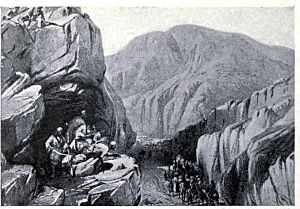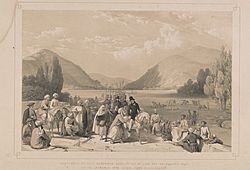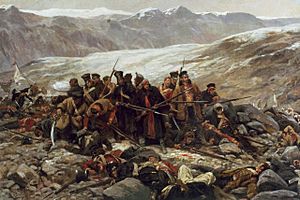First Anglo-Afghan War facts for kids
Quick facts for kids First Anglo-Afghan War |
|||||||
|---|---|---|---|---|---|---|---|
| Part of the Great Game | |||||||
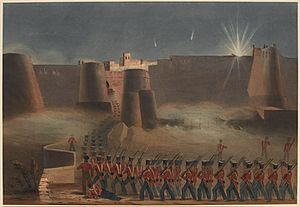 Lithograph depicting British-Indian force storming the fortress during the Battle of Ghazni, 23 July 1839 |
|||||||
|
|||||||
| Belligerents | |||||||
Principality of Qandahar Khanate of Kalat Khulm (August 1840, November 1841 onwards.) Marri Bugti Afghan Tribes Barakzai Loyalists |
Supported By: |
||||||
| Commanders and leaders | |||||||
Afzal Khan (WIA) Mir Masjidi Khan X Akhtar Khan Haidar Khan Nawab Jabbar Khan Akram Khan Nawab Muhammad Zaman Kohandil Khan Rahmdil Khan Abdullah Khan Achakzai Aminullah Khan Logari Mir Wali of Khulm (November 1841 onwards) |
Shujah ul-Mulk X Fath Jang Timur Mirza Sultan Shahpur Mir Wali of Khulm (August 1840-November 1841) Hajji Khan Kakar |
||||||
The First Anglo-Afghan War was a major conflict between the British Empire and the Afghan Emirate of Kabul. It took place from 1838 to 1842. The British first successfully invaded Afghanistan. They took sides in a fight over who should rule. This was between the Afghan leader Dost Mohammad and the former ruler Shah Shujah.
The British put Shah Shujah back on the throne after taking Kabul in August 1839. A large British-Indian army stayed in Kabul through harsh winters. Most of this force and its helpers were killed during a terrible retreat in 1842.
Britain then sent a new army to Kabul to get revenge and rescue prisoners. After this, they left Afghanistan. Dost Mohammad Khan returned from exile in India and became ruler again. This war was one of the first big events in the "Great Game". This was a 19th-century power struggle between Britain and Russia in Central Asia.
Contents
Background to the War
Why the War Started
The 1800s were a time of intense competition between the British and Russian empires. Both wanted to control areas in South Asia and Central Asia. The British called this rivalry the "Great Game." The Russians called it the "Tournament of Shadows."
Britain worried that Russia might try to invade British India. They feared Russia would come through Afghanistan. British leaders like Lord Palmerston believed Afghanistan was unstable. They also saw the growing power of the Sikh Empire as a threat.
In 1834, Shah Shuja Durrani tried to invade Kandahar with British help. But he was defeated.
The British East India Company sent a diplomat to Kabul. They wanted to make an alliance with Afghanistan's ruler, Dost Mohammad Khan. They wanted his help against Russia. However, the British were also worried about the powerful Sikh army. They thought the Sikhs were a bigger threat than the Afghans.
When the British Governor-General, Lord Auckland, heard a Russian diplomat had arrived in Kabul, he got worried. His advisors made the threat seem bigger than it was. Dost Mohammad had invited the Russian diplomat to scare the British. He wanted Britain to ally with him against the Sikh ruler, Ranjit Singh.
In January 1838, Lord Auckland sent a strong message to Dost Mohammad. He told him to stop talking to Russia and give up his claims to Peshawar. Dost Mohammad was offended but tried to find a compromise. However, the British diplomat had no power to negotiate. So, Dost Mohammad sent the British mission away in April 1838.
British fears grew when talks between Afghans and Russians failed. Persia, with Russian support, tried to capture Herat in Afghanistan. Herat was important because it had very fertile land. Britain wanted to stop Persia and replace Dost Mohammad with Shah Shuja. Shah Shuja had ruled Afghanistan before and was willing to ally with Britain. He had been living in exile in British India since 1818.
On October 1, 1838, Lord Auckland announced the invasion. He claimed Shah Shuja was "popular throughout Afghanistan." He said the British army would support him. However, the reasons for the invasion had disappeared. Persia had stopped its attack on Herat. Russia had called its diplomat home.
Despite this, Lord Auckland was determined to bring Afghanistan under British influence. On November 25, 1838, the British and Sikh armies held a grand parade. Lord Auckland announced that the "Grand Army of the Indus" would march to Kabul. Their goal was to remove Dost Mohammad and put Shah Shuja back on the throne. The Duke of Wellington, a famous British general, criticized the plan. He called it "stupid" and predicted that holding Afghanistan would be very difficult.
Armies Involved
At this time, the East India Company ruled India. It was a powerful trading company that had been given the right to govern India by the British Crown. The Company had its own huge army of 200,000 soldiers. Most of these soldiers were Indian, but the officers were British. The British Army also sent its own regiments to India.
The British forces for the invasion came from the Bengal and Bombay armies. They included both Company regiments and British Army regiments. Shah Shuja also hired 6,000 Indian soldiers. The Sikh ruler, Ranjit Singh, agreed to help the British. His troops marched through the Khyber Pass. The invasion force included 38,000 Indian helpers and 30,000 camels to carry supplies.
Afghanistan did not have a regular army. Instead, tribal chiefs provided fighters when the Emir (ruler) needed them. Afghans were divided into many ethnic groups and tribes. Most men had some fighting experience from tribal conflicts. Their main weapon was a type of rifle called a jezail. The Pashtun tribes followed a strict code called Pashtunwali. This code included rules about avenging insults with violence.
The War Begins
British Invasion of Afghanistan
The "Army of the Indus" began its march in December 1838. It had 21,000 British and Indian soldiers. They were led by John Keane, 1st Baron Keane. The army also had a huge number of 38,000 helpers and 30,000 camels. British officers brought many personal items, showing they expected a comfortable trip.
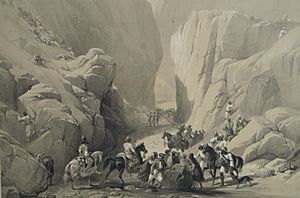
By March 1839, the British crossed the Bolan Pass. They reached Quetta and continued towards Kabul. They traveled through difficult mountains and deserts. On April 25, 1839, they set up camps at Kandahar.
On July 23, 1839, the British forces launched a surprise attack. They captured the fortress of Ghazni. This fortress was important because it controlled the path to Kabul. British troops blew up one of the city gates and marched in. The British had 200 killed or wounded, while the Afghans lost 500 killed and 1,500 captured. Ghazni had many supplies, which helped the British advance.
After Ghazni, the British marched to Kabul without much resistance. Dost Mohammad offered to accept Shah Shuja as his ruler if he could remain a chief. But this offer was refused. In August 1839, Shah Shuja was put back on the throne in Kabul. He was known for being cruel and was not popular with his own people.
Dost Mohammad Flees and Resistance Grows
Shah Shuja's rule was very unpopular. Resistance against the British began in late 1839. Tribesmen attacked the Kabul-Ghazni road. Dost Mohammad tried to get help from other rulers in Central Asia.
In the winter of 1839, Dost Mohammad went to Bukhara to ask for help. He was first welcomed but then treated like a prisoner. He managed to escape the next summer. Even though his family was captured by the British, Dost Mohammad refused to give up.
A leader named Mir Wali gathered over 6,000 Uzbek fighters. In September 1840, they forced the British to retreat from some outposts. Many Afghan soldiers helping the British switched sides. Dost Mohammad then marched on Bamiyan. However, he was defeated by a British force led by Colonel Dennie.
After this victory, the British offered Dost Mohammad a safe exile in India if he surrendered. But Dost Mohammad said he was "determined to conquer or fall."
Battle of Parwan Darra and Dost Mohammad's Surrender (1840)
On November 2, 1840, Dost Mohammad's forces fought the British at Parwan Darra. Dost Mohammad had a strong defensive position. A British cavalry charge failed, and many British officers were killed. The Afghan cavalry then chased and killed many British soldiers.
The British infantry managed to capture the ridge after heavy fighting. But Dost Mohammad's forces retreated in good order. The British suffered many losses and were running low on supplies. They had to abandon the campaign.
Despite the British retreat, Dost Mohammad surprised everyone. On the evening of November 2, 1840, he rode up to the British diplomat, William Hay Macnaghten. Dost Mohammad Khan surrendered to the British. He was then sent to exile in India.
British Occupation and Afghan Uprising
Most British troops returned to India, but 8,000 remained in Afghanistan. It became clear that Shah Shuja could only rule with British support. Afghans disliked the British presence and Shah Shuja's rule.
The British diplomat, William Hay Macnaghten, allowed soldiers to bring their families. This made Afghans even angrier, as it seemed the British planned to stay forever. British officers lived comfortably, playing sports and having parties.
Afghanistan did not have a modern army. The British tried to make Shah Shuja create one, but he refused. This threatened the power of the tribal chiefs.
In September 1841, Macnaghten cut the payments given to Ghilzai tribal chiefs. These payments were bribes to keep them loyal and the mountain passes open. This immediately led to the Ghilzais rebelling and declaring a holy war. Macnaghten did not take the threat seriously at first.
On November 1, 1841, Afghan chiefs met to plan an uprising. It began the next day, November 2. The British situation quickly worsened. Afghans captured a poorly defended supply fort in Kabul on November 9.
British commanders tried to negotiate with Akbar Khan, Dost Mohammad's son. Macnaghten secretly offered to make Akbar a powerful minister if the British could stay. At the same time, he tried to have Akbar assassinated. Akbar found out about this.
On December 23, Macnaghten met Akbar Khan for talks. But Macnaghten and three other officers were captured and killed by Akbar Khan. Macnaghten's body was dragged through the streets of Kabul. The British commander, Major-General William Elphinstone, had already lost control of his troops. His authority was now completely broken.
Destruction of Elphinstone's Army

On January 1, 1842, an agreement was made for the British to leave Afghanistan safely. Five days later, the withdrawal began. The British group had about 16,500 people. Around 4,500 were soldiers, and over 12,000 were helpers. Lady Sale, a British officer's wife, brought 40 servants with her.
As they marched through snowy mountain passes, Ghilzai warriors attacked them. On the first day, they only went five miles. Lady Sale wrote that it was freezing, and there was no food. On the second day, all the Afghan soldiers helping the British deserted.
Despite Akbar Khan's promise of safe passage, the British-Indian force was attacked repeatedly. One fierce attack was stopped by a bayonet charge from the 44th Foot regiment.
While crossing the Koord-Kabul pass, the force was ambushed. Many helpers were killed. The British commander, Elphinstone, still believed Akbar Khan was his ally. He believed Akbar's promise to send supplies if they stopped. That night, a terrible blizzard hit, and hundreds froze to death.
On January 9, Akbar offered to take all British women and children as hostages. He promised they would not be harmed. Lady Sale and other British women and children accepted this offer. Akbar refused to take Indian women and children. They died with the rest of the force.
On January 10, the column continued its march. Everyone was tired, hungry, and cold. Many Indian soldiers had frostbite and could not fire their guns. At a narrow pass, the Ghilzai tribesmen ambushed them again. They killed many helpers. The British soldiers fought their way through with heavy losses. Akbar Khan watched the slaughter from a hill.
On January 11, General Elphinstone and other officers met Akbar Khan. Akbar told them they were now his prisoners. Command of the remaining British force fell to Brigadier Thomas Anquetil.
The retreating soldiers were killed in huge numbers as they went through dangerous gorges and passes. At Gandamak, about 20 officers and 45 soldiers of the 44th Foot regiment were surrounded. They fought bravely until they ran out of ammunition. They then fought with bayonets and swords until they were overwhelmed. Only a few were taken prisoner. The only British soldier to reach the besieged British garrison at Jalalabad was Dr. William Brydon.
Many women and children were taken captive by the Afghan tribes. Some of these women married their captors. Children taken from the battlefield were raised by Afghan families.
Second British Expedition
While the Kabul garrison was under attack, other British forces in Afghanistan were also in trouble. These were in Kandahar, Jalalabad, and Ghazni. Ghazni was captured by the Afghans. But the other British forces held out until help arrived from India in spring 1842. Akbar Khan was defeated near Jalalabad.
Lord Auckland had been replaced as governor-general by Lord Ellenborough. Ellenborough ordered the British forces to leave Afghanistan. But first, they were to get revenge and free the prisoners.
In August 1842, General William Nott marched from Kandahar. He captured Ghazni and partly destroyed its forts. Meanwhile, General George Pollock led a new force through the Khyber Pass to Jalalabad. From there, General Pollock defeated Akbar Khan again. As the British forces advanced, they saw the bodies of their comrades from the earlier retreat. This made them angry, and they took revenge on Afghan villages.
The combined British forces defeated all resistance. They captured Kabul in September. A month later, they rescued the prisoners. They also destroyed Kabul's main market as revenge for the earlier massacre. Then, they left Afghanistan through the Khyber Pass. Dost Muhammad was released from exile and became ruler of Kabul again. He died in 1863.
Dost Mohammad is said to have commented on the British:
I have been struck by the magnitude of your resources, your ships, your arsenals, but what I cannot understand is why the rulers of so vast and flourishing an empire should have gone across the Indus to deprive me of my poor and barren country.
Aftermath of the War
Many people in Britain criticized the war. They thought it was a bad idea. The threat from Russia was much smaller than believed. It would have been very hard for Russia to invade India.
In the decades after this war, Russia did expand south towards Afghanistan. But the First Anglo-Afghan War was a huge defeat for the British. It was called the "greatest military humiliation of the nineteenth century" for them.
In 1878, the British invaded again, starting the Second Anglo-Afghan War.
Lady Butler's famous painting, Remnants of an Army, shows Dr. William Brydon arriving at the British outpost in Jalalabad. He was thought to be the only survivor of the terrible retreat. This painting helped create Afghanistan's reputation as a "graveyard for foreign armies."
In 1843, a British army chaplain wrote about the war. He called it "a war begun for no wise purpose, carried on with a strange mixture of rashness and timidity, brought to a close after suffering and disaster, without much glory." He said no good came from the war.
The Church of St. John the Evangelist in Mumbai, India, was built in 1852. It is a memorial to those who died in the war.
Battle Honours
The battle honour 'Afghanistan 1839' was given to British East India Company army units. This was for their service in the war.
In Popular Culture
- The war was shown in an 1842 panorama in London.
- The novel Flashman by George MacDonald Fraser is set during this war.
- The story of Dr. Brydon may have inspired the character of Dr. John Watson in the Sherlock Holmes novels.
- Several other novels, like Emma Drummond's Beyond all Frontiers and Philip Hensher's Mulberry Empire, are based on these events.
- G.A. Henty's children's novel To Herat and Kabul focuses on the war.
- The TV series Victoria (2017) shows Brydon's survival in the retreat.
See also
- Military history of Britain
- Military history of Afghanistan
- European influence in Afghanistan
- Invasions of Afghanistan
- Second Anglo-Afghan War
- Third Anglo-Afghan War


